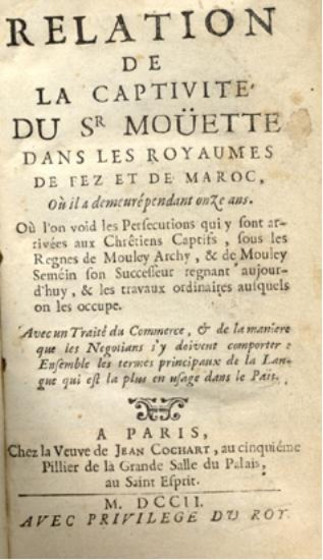RELATION DE CAPTIVITÉ DU SR. MOÜETTE DANS LES ROYAUMES DE FEZ ET DE MAROC, OÙ IL A DEMEURÉ PENDANT ONZE ANS.
Mouette, Germain
| Numéro d'objet: |
471 |
| Date: |
1702 |
| Genre: |
Livre |
| Lieu: |
Paris |
| Sujet: |
Captifs |
Recherche dans "Notes":
[MOUETTE Germain]
Relation de la captivité du Sr Moüette dans les royaumes de Fez et de Maroc, où il a demeuré pendant onze ans. Où l'on voit les persécutions qui y sont arrivées aux chrétiens captifs, sous les règnes de Mouley Archy et de Mouley Seméin.. et les travaux ordinaires auxquels on les occupe... Paris, Jean Cochart 1702 in-12 veau brun, dos à nerfs orné. (xii)-362-(xii) p. (Playfair 295 - Lebel 65 - Turbet-Delof 248) Pour Turbet-delof comme pour Lebel, les histoires de cette "Relation" sont un chef d'oeuvre, d'où le fait que Moüette a disputé à trois auteurs au moins le propriété de son oeuvre. Pris dans la Manche le 16 octobre 1670 Moüette est à Salé le 24 octobre; il avait trente ans quand il fut racheté, en 1681, après onze ans d'esclavage. Sa "Relation est bâtie sur le même plan que celle d'Aranda. Elle comprend un récit suivi de la captivité de l'auteur, puis six nouvelles. Le chapitre dernier est un glossaire français-arabe de 900 mots et locutions. Moüette, lors de sa captivité, a eu le temps d'apprendre les deux langues employées dans le pays: l'arabe et l'espagnol.
1682. Moüette, Sieur. – Relation de Captivité du Sr. Moüette dans les Royaumes de Fez et de Maroc, où il a demeuré pendant onze ans. Où l'on void les Persecutions qui y sont arrivées aux Chrêtiens Captifs, sous les Regnes de Mouley Archy, & de Mouley Seméin son successeur regnant aujourd'huy, & les travaux ordinaires auxquels on les occupe. Avec un Traité du Commerce, & de la maniere que les Negotians s'y doivent comporter : Ensemble les termes principaux de la Lanoue, qui est la plus en usage dans le Païs. Paris : 12mo, pp. x + 362 + 10.
Another edition : Paris, 1702.
The last chapter contains an Arabic vocabulary and a list of the provinces and towns of Morocco.
Translated into Dutch in Van der Aa's « Zee en Land Reysen, » (1707) and into English in « A New Collection of Voyages and Travels into several Parts of the wolrd. None of them ever before Printed in English. » London 4to, « Printed for J. Knapton, Andrew Bell, D. Midwinter, Will.Taylor, and J. Baker, » 1711. Moüette's « Travels in the kingdoms of Fez and Morocco during his eleven years' captivity in those parts » occupies from pp. 1-115, with contents and index, and with the Taleb-Bongeman's map. Of this Taleb, Moüette gives an interesting account. He had been Secretary to the Kaïd Sidan, one of « Mouley Archy's » (Er-Rashîd) favourites. When Sidan was murdered by « the great men of the kingdom, » Bongeman's goods at Old Fez were plundered, and the owner expelled by the citizens. He then retired to New Fez, and pursued the business of painting and making fretwork in plaster, which he had learnt in his youth. Moüette being set on the same kind of work, became intimate with Bongeman, and obtained from him most of the information he has embodied in his books. The fallen Secretary also drew his map, the accuracy of which was attested by « several Christians who had travelled with Muley Archy, about his train of artillery. » This map was obtained from Moüette by a trick of the Sieur Gontier, brother of the French Consul at Salli. But he kept a copy during his captivity, though it is not engraved in the first edition of his
« Relation ».
The volume containing the English translation, which also contains Peter Teixeira's « Travels from India to Italy by land », Francis Cauche of Roan's « Voyage to Madagascar » , Tellez's « Travels of the Jesuits in Ethiopia », also separately indexed and dated, was reprinted in 1718, London, 4to, and is accounted among the rarest of such works. A summary appeared also in Stephen's « Collection of Travels », 4to. vol. ii.
« I set out from Paris, » the Sieur Moüette tells us, « on the last day of July1670, with my cousin Claude Loyer la Garde, and a friend of ours, designing for the West Indies. Being come to Dieppe, we embarked there on the 16th of September, paying 56 livres each for our passage, in a small vessel of 120 tons and 6 guns, called the Royal, and commanded by Isaac Beliare, of Dieppe. After, we embarked Madame de la Montgne, whose husbund had been commander of the ancient inhabitants of the Island of St. Christopher, and she was returning thither with the Knight [of Malta] her son, and some men and women servants. The same day thither there came aboard of us a young gentleman of that country, who had fled from his father, having had the misfortune to kill his elder brother, whom his father loved entirely. »
After battling with gales, they were captured by two Saleitines, and carried into slavery, on the 24th October, 1670. One of the pirates, having been chased by an English war-ship, managed to escape into Fidella ; the other, on board of which was Moüette, ran ashore near Sallee, Madame de Montagne being drowned in the attempt to get ashore. This narrative of his adventures is one of the most interesting in the entire range of the pathetic stories of Christian slavery. Moüette was ransomed in 1680 by the RR. PP. de la Mercy.

